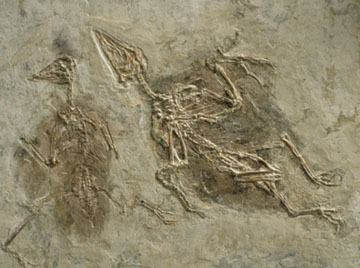
 |
|
|
Fossil faux pas
In the midst of the fairly accepted theory that dinosaurs are the evolutionary ancestors of birds, a cracked egg is revealing some unpleasant odors.
|
Last October, scientists funded by the National Geographic Society announced at a well-publicized press conference the discovery of a fossilized creature that had the body of a bird and the tail of a dinosaur. They claim the fossil, named Archaeoraptor liaoningensis, appeared to be the next transition after Archaeopteryx, long viewed as the key link between dinosaurs and birds. But to their chagrin, the “dromaeosaur-like primitive bird” may be a feathered chimera. A recent discovery in China of the counterpart to the fossil’s tail has increased skepticism and concern that the fossil is a composite. In light of the controversy at the time of this writing, the National Geographic Society refused to release images of Archaeoraptor — which was first described in the November issue of National Geographic magazine. |

|
“We were caught out of stride,” says Philip J. Currie of the Royal Tyrrell Museum of Paleontology in Drumheller, Alberta. Currie was one of the scientists originally studying the fossil. “Certainly if we were aware of the evidence that Xu has found we would have done things differently.”
From the beginning many paleontologists, including those most familiar with the fossil, had their doubts about the fossil’s credibility. It came from Liaoning Province, China, where farmers or businessmen excavating fossils are known for their creative tendencies of piecing together fossils of supposed missing parts or carving features in for aesthetic purposes (see image above). These fossil forgeries are sold to the highest bidder and then often illegally exported and mistaken for authentic specimens.
“Our suspicion was raised initially because of the visible break between the skeleton,” Currie says. The ramrod straight tail and the rest of the body seem disconnected when viewed with the naked eye. In July, CT scans of the fossil done by Tim Rowe of the Vertebrate Paleontology Laboratory at the University of Texas in Austin confirmed bones were missing between the tail and the pelvis.
“This is always an issue with commercially acquired specimens where economic values may supercede scientific concerns,” says Richard Stucky, vice president of the Society of Vertebrate Paleontology. “Fabrications and enhancement are not uncommon and must always be considered when a specimen is acquired commercially rather than through a scientific expedition.”
“It’s always a slippery slope when you’re forced to work with
a specimen whose ori
gin you don’t know,” says Paul Sereno of the University of Chicago.
Still, Currie, Stephen Czerkas of the Dinosaur Museum in Blanding, Utah, and Xu originally found evidence that convinced them Archaeoraptor was one animal.
“We measured the vertebrae in the tail and compared it to the vertebrae
in the front and it was not unreasonable to believe
they went together,” Currie says. Thin sections of the rock and comparisons
of color
and texture also convinced them they had something unique.
Confident about the specimen, they submitted their report to the scientific community, but both Nature and Science rejected it. By then, Czerkas says, it was too late to retract the coming article in National Geographic. Not long after the press conference on Oct. 15, the rumors and allegations began.
Storrs Olson, an assailant against the theropod ancestry of birds, considers the forgery a prime example of one camp of scientists holding too closely to a “pet theory.” Although no formal presentations were made about the fossil at the annual meeting of the Society of Vertebrate Paleontology (SVP) in late October, “it was common knowledge at that meeting that this specimen was a hoax,” says Olson, curator of the division of birds at the Smithsonian Institution.
|
"This one slipped by for reasons parallel to the Piltdown hoax." Paul Sereno |
How common however is questionable. Others at the meeting either were not aware of the discussion or heard very little. “People who seemed to know something about it said it was a chimera,” says Dale Winkler, treasurer of SVP. Stephen Czerkas, whose museum arranged for the purchase of the fossil through a benefactor at a gem and mineral show for $80,000, is waiting to view the fossils together before casting doubt on Archaeoraptor. |
It is this faith in the fossil that other scientists are criticizing. “A perfect missing link should be looked at very carefully,” says Hans-Dieter Sues, vice president of collections and research at the Royal Ontario Museum.
“This one slipped by for reasons parallel to the Piltdown hoax,” Paul Sereno said, referring to what is often considered the greatest hoax in history: the human skull that fooled paleontologists from 1912 to 1953 with an orangutan jaw, stained to look old.
“It looked like a fossil human, and was undetected, because it was in the form scientists were expecting to find.”
Christina Reed